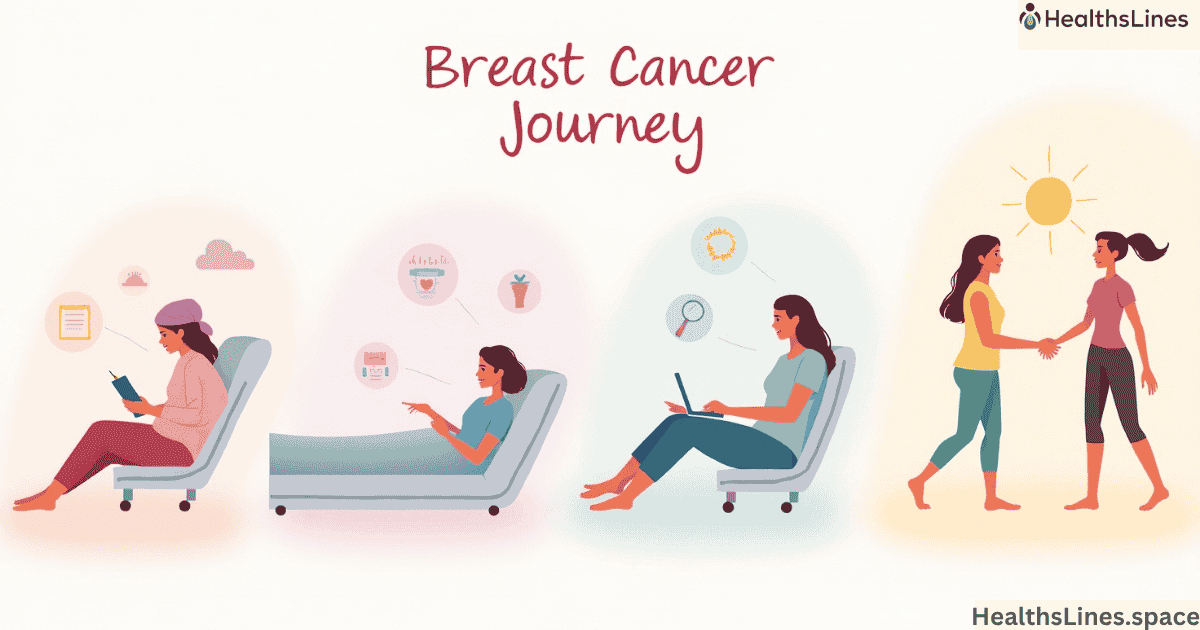Moving Forward with Strength
Exercise during breast cancer is not about pushing your limits. It’s about helping your body heal. Movement helps your body manage treatment side effects Exercising With Breast Cancer. It lifts your mood and keeps your strength up. When you’re going through something hard like chemotherapy or radiation, it’s normal to feel tired. But even gentle movement can make a difference. Exercise helps your body fight back.
Doctors now recommend physical activity during chemotherapy because it boosts energy. It also helps your immune system stay strong. Exercise is good for your heart, muscles, bones, and your mind. The goal isn’t to become an athlete. The goal is to feel better, day by day. This guide gives you real advice you can use now. These tips will help you create a safe and effective fitness routine that works with your body.
Benefits of Exercise During Breast Cancer
Exercise during breast cancer treatment offers numerous benefits that can significantly improve both physical and mental well-being. Engaging in regular physical activity helps reduce cancer-related fatigue, a common side effect of treatments like chemotherapy and radiation. Even light exercises, such as walking or gentle stretching, can boost energy levels and enhance sleep quality, leading to better overall functioning during the day. Moreover, exercise has been shown to alleviate anxiety and depression, contributing to a more positive outlook during treatment.
Beyond immediate symptom relief, maintaining an active lifestyle during breast cancer treatment may lower the risk of cancer recurrence. Physical activity aids in regulating hormones, reducing inflammation, and strengthening the immune system, all of which play roles in cancer prevention and recovery. Studies have indicated that women who remain active during treatment experience fewer complications and have improved survival rates Exercising With Breast Cancer. Incorporating safe workouts for cancer patients, such as low-impact aerobic exercises and strength training, can also help manage weight, preserve muscle mass, and improve cardiovascular health, further supporting the body’s resilience during and after treatment.
Know Your Body – Exercise Changes During Cancer
Cancer changes the way your body feels and works. You may have less energy. You might feel dizzy, sore, or stiff. Some days you can walk a mile. Other days, walking to the kitchen feels hard. That’s okay. You don’t need to do the same thing every day. Your body is doing something huge—it’s healing. So it’s important to adjust your routine.
It’s also important to know when not to exercise. If you have a fever, chest pain, or dizziness, it’s time to rest. Always check with your doctor before you begin. Your care team can guide you on what is safe. Breast cancer physical therapy may be part of your recovery. They help guide safe workouts for cancer patients. They also support your body through every stage.
Types of Safe Exercises for Breast Cancer Patients

If you’re wondering what kind of movement is safe during breast cancer treatment, the good news is—there are many gentle options that support healing. The best exercises are low-impact and easy on your joints, especially when you’re dealing with cancer-related fatigue or soreness. Walking is one of the easiest and most effective ways to stay active. A short daily walk helps your heart, boosts your mood, and keeps your energy from dipping too low.
Swimming and stationary cycling are also great low-impact choices. These activities improve circulation and keep muscles working without straining your body. If you’re looking for something calming, try yoga or tai chi. Both combine deep breathing, stretching, and balance Exercising With Breast Cancer. These movements not only relax your nervous system but also reduce anxiety and improve sleep. After breast cancer surgery, these gentle stretches help ease stiffness in the chest, arms, and shoulders.
Strength training is another key piece of recovery. You don’t need heavy weights. Even light resistance bands or two-pound dumbbells can help you maintain muscle tone. This matters because treatment can cause muscle loss and bone thinning. Gentle strength work supports your posture and reduces the risk of falls.
The most important thing is to listen to your body. Start small, like five or ten minutes a day, and build slowly. Always check with your medical team before starting something new Exercising With Breast Cancer. Safe movement isn’t just possible—it’s powerful. With the right routine, you can stay strong during treatment and beyond.
Guidelines for Exercising Safely with Cancer
When it comes to safe fitness for metastatic cancer or early-stage breast cancer, go slow. Don’t worry about reaching a certain number of steps or miles. The key is consistency and listening to your body. Start with five or ten minutes a day. If you feel okay, add a little more each week.
Here’s a basic table to guide your routine:
| Treatment Stage | Suggested Movement |
| During Chemotherapy | Short walks, gentle yoga, chair yoga |
| Post-Mastectomy | Light stretching, guided PT |
| Radiation Therapy | Breathing exercises, light cardio |
| Remission & Beyond | Strength training, walking, swimming |
Pay attention to signs like dizziness, shortness of breath, or swelling. These can mean you need to stop and rest. Always hydrate and avoid working out in extreme heat. These rules apply even for experienced fitness lovers.
Adjusting After Surgery or Port Placement
If you had a mastectomy, stretching after breast surgery becomes essential. After surgery, many women feel tightness in their chest or shoulder. Lifting your arms or reaching for something may feel hard. Don’t force it. Healing takes time. Begin with small arm movements guided by a physical therapist. These breast cancer recovery exercises help prevent long-term stiffness.
If you have a port in your chest for treatment, some moves might not feel right. Avoid pushing or pulling on the side where the port is placed. Avoid heavy lifting until cleared by your doctor. Lymphedema exercise tips may also be necessary if lymph nodes were removed. Swelling in your arm can happen, and exercises can help reduce it. A trained specialist in oncology physical therapy can show you what’s safe.
Building a Personalized Plan with a Specialist
Every person’s journey is different. That’s why it’s smart to get help from a pro. A certified trainer who has worked with cancer patients knows how to adjust routines. Breast cancer physical therapy or a cancer rehab specialist helps track your recovery. They create a plan based on your treatment, energy level, and goals.
Programs like the Live strong exercise program offer free or low-cost fitness sessions. These are created just for cancer survivors Exercising With Breast Cancer. Hospitals or cancer centers often have in-house specialists. Some even offer virtual sessions so you can exercise from home. A one-size-fits-all approach doesn’t work when your body is healing. Customized care ensures safety and results.
Staying Motivated When You’re Tired or Discouraged
Some days you’ll feel tired. That’s normal. Fatigue during cancer treatment can make everything feel harder. The trick is to focus on small wins. Even standing and stretching for five minutes counts. Use a calendar to track what you do. It’s not about perfection. It’s about progress. Every step is a victory.
Joining a support group or online fitness class helps. Knowing others are on the same journey gives strength. Remind yourself often: exercise is medicine. You’re not just working out—you’re healing. Find what brings joy. Maybe it’s dancing to a song or taking a quiet walk outside. That joy keeps you coming back.
How to Exercise During Remission or Metastatic Cancer

When you’re in remission or living with metastatic breast cancer, fitness still plays a big role. You may need to adjust how often or how hard you exercise. That’s okay. Movement still helps you manage side effects and keep your independence.
For women with stage IV breast cancer, energy can come and go. Some days you may want to walk. Other days, you may only stretch. That’s valid. Chair exercises for cancer patients are perfect for low-energy days. Gentle movement can boost your mood, digestion, and circulation without draining your strength. Healing is not linear, and neither is fitness.
Exercise Myths and What the Research Really Says
One big myth is that rest is better than exercise during treatment. That used to be the advice. Now, we know gentle movement after cancer treatment improves outcomes. Rest is important, but too much can lead to weakness. The new message is: move to heal.
Another myth is that only cardio matters. But strength training during cancer helps reduce fatigue and supports bone health. Some worry that moving too much will make cancer spread. This is false. In fact, cardio for breast cancer patients improves blood flow and oxygen delivery. These changes support healing, not harm it. Trust the science—it’s on your side.
Tools, Gear, and Resources That Help
You don’t need fancy equipment. A yoga mat, a chair, and a light set of dumbbells are a great start. A small set of resistance bands can also add variety. Use free apps that guide workouts for people in treatment. Keep a notebook to log your progress and feelings after each session.
Here’s a quick list of useful tools:
| Tool | Purpose |
| Resistance Bands | Strength and flexibility |
| Yoga Mat | Comfort for floor exercises |
| Small Weights (2-5 lbs) | Muscle maintenance |
| Chair | Support during balance moves |
| Water Bottle | Stay hydrated |
| Fitness App (like MyFitnessPal) | Tracking movement & reminders |
Simple tools. Big impact. Use what you have. Build slowly and celebrate your consistency.
Final Thoughts
When it comes to exercising with breast cancer, you’re not just helping your body—you’re caring for your whole self. Whether you’re in the middle of treatment or on the other side of it, movement is medicine. With the right guidance and pace, breast cancer and physical activity can go hand-in-hand.
Always check with your care team, and don’t compare your progress with others. You’re on your own path. Some days will feel easier than others. And that’s okay. What matters is that you move forward, one step at a time.
For more help with a breast cancer exercise guide, reach out to local hospitals or cancer centers. Many offer group exercise classes for survivors, one-on-one sessions, or referrals to specialists in cancer rehabilitation exercises. Don’t be afraid to ask for support. You deserve to feel strong, safe, and well.












